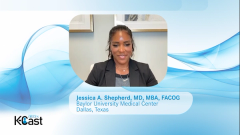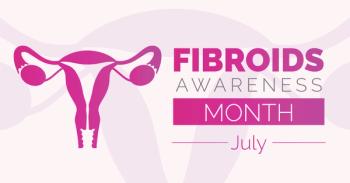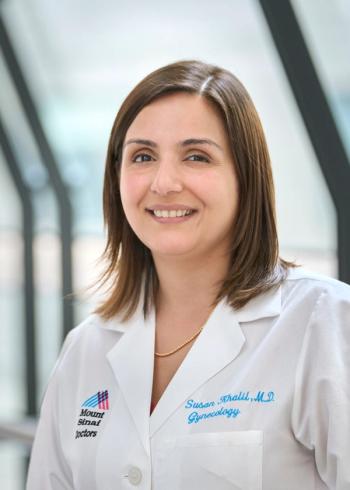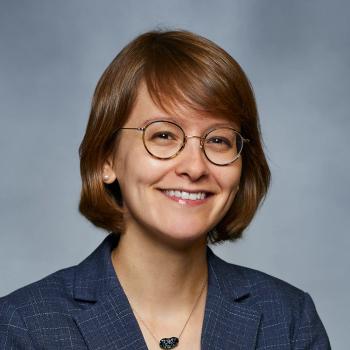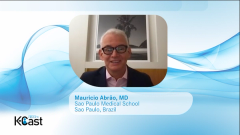
Unmet Needs in the Management of Uterine Fibroids
Mauricio Abrão, MD, and Jessica A. Shepherd, MD, MBA, FACOG, address gaps in care for the treatment of uterine fibroids and share the importance of patient education in disease management.
Episodes in this series

Jessica A. Shepherd, MD, MBA, FACOG: Despite the recent advances in the treatment landscape, as we conclude our conversation, what would you say are the gaps that remain in the care of patients with uterine fibroids? How do you see that being addressed in the future?
Mauricio Abrão, MD: When we talk about the future, we should start with a better understanding of the physiopathology of fibroids. Because when we better understand the role of the extracellular matrix, the genetic options, and the interactions between oncogenes and the growth of the fibroid, we stop thinking about hormones to treat the disease and we’re going to treat the growth of the fibroids. This is the dream. This is the same as when we talk about the future of treating endometriosis. What we have now are hormonal treatments. In the future, by defining the genetic pathways, we may have solutions that may be even better because we’re not going to talk about adverse effects and things like this.
In the future, we may also have better tools to help with diagnosis. Look at the example of when we talk about laparoscopy to treat fibroids. It will also help us define the difference between fibroids and sarcomas. If we have a better pre-operative diagnosis defining precisely, “No, this isn’t a sarcoma,” you can do a treatment without being afraid of disseminating the tumor or things that are relevant. Options for robotic surgeries are growing a lot and may be part of this future. What do you think?
Jessica A. Shepherd, MD, MBA, FACOG: I’m very passionate about where we are in research and the research dollars that go to women’s health. But also from an education standpoint, there are so many gaps in education that we need to do a better job at, whether that’s within the examination room, with what’s available for women to understand, and even with men understanding a women’s health issue. We know that age, income level, health insurance, and health care proactivity all impact the health outcomes that we see for all diseases. But specifically for fibroids, we know that women’s health conditions can have overlapping symptoms that women are unsure of and don’t realize may be devoted to a fibroid.
There’s also the negativity that we’ve seen in the past toward fibroid and fibroid health. We need to create more health equity when it comes to talking about this particular topic in general because it impacts more Black women than any other race, like we discussed. The real concern is how we reach a certain community within fibroids to get to the heart of why this is impacting women’s lives to such great numbers.
That sometimes comes down to genetics. If we were thinking of precision medicine and more from a genetic perspective on how we can impact the genetic foundation of fibroids through research, and therefore, maybe even get to a point where we see fewer fibroids overall, that would impact these outcomes and adverse effects that we’re talking about. But if we found a way to decrease fibroids in general from a genetic standpoint, then we wouldn’t necessarily have to place so much emphasis on the treatment of fibroids because we’ve impacted the actual disease state itself. Patient education, research, and increasing awareness is where we need to focus our efforts, just like you stated.
Mauricio Abrão, MD: I completely agree, Jessica. This is why the AAGL [American Association of Gynecologic Laparoscopists] is probably one of the main gynecological surgical societies worldwide. We just finalized our strategic planning thinking of the next years. One of the most important pillars is how much we’re going to invest in research and become more scientific for this society. The other one is the investment that we’re going to make on education. Education isn’t only to educate doctors, it’s to bring patients to the discussions and educate patients about the advocacy groups. It’s part of the present that we need to invest in a lot. This is one of the goals of this year, being the president of this society.
Jessica A. Shepherd, MD, MBA, FACOG: I’m glad that you’re taking that initiative and that stand because it comes from a standpoint of leadership to help everyone else understand exactly what the agenda is and where we need to change the course when we think of women’s health. From our discussion, which I’m so delighted that I’ve been able to share this time with you, it’s clear that we have seen that being proactive with one’s health and overall wellness is key for understanding the disease state and what comes with that.
When we think from a uterine fibroid standpoint about fibroid symptoms and potential treatments, the core of what we should be focusing on is that mission to educate women about their bodies, uterine fibroids, and all the treatments that we’ve been able to discuss through this discussion. I’m very hopeful that this will help others learn about new technology and innovation and help counsel patients better. As a community of physicians and OB/GYNs, we can use these discussions to propel ourselves forward in our professions, our research, and in women’s lives.
Mauricio Abrão, MD: That’s it. I’d like to thank Contemporary OB/GYN® for this great initiative for us to do this KCast video program. Things like this are very helpful for us to disseminate the right information, as we’re doing here. It’s very nice to be with you here, Jessica. It was a great pleasure.
Transcript Edited for Clarity
Newsletter
Get the latest clinical updates, case studies, and expert commentary in obstetric and gynecologic care. Sign up now to stay informed.


